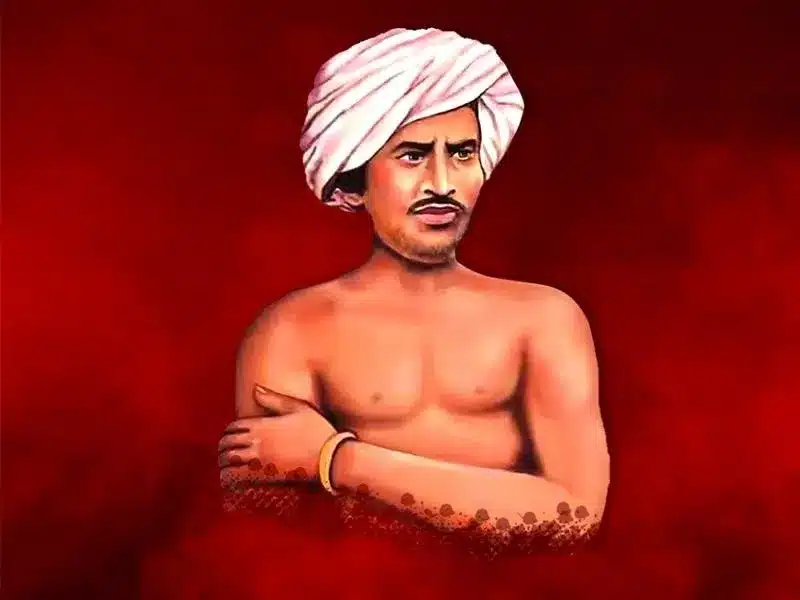About Birsa Munda:
- He was a folk hero and a tribal freedom fighter who played a pivotal role in the Indian independence movement, particularly in the tribal regions of British India.
- He belonged to the Munda tribe in the Chhotanagpur Plateau area.
- He spearheaded an Indian tribal mass movement that arose in the Bihar and Jharkhand belts in the early 19th century under British colonisation.
- Munda rallied the tribals to fight against the forceful land grabbing carried out by the British government, which would turn the tribals into bonded labourers and force them to abject poverty.
- He influenced his people to realise the importance of owning their land and asserting their rights over it.
- Birsa encouraged the tribe to stick to their traditions and get back to their tribal roots.
- One of Birsa’s notable contributions was the formation of the Munda Rebellion, also known as the Ulgulan, or the Tamar Revolt, in the late 19th century.
- The rebellion was a response to the oppressive policies of the British administration, including the introduction of the Forest Laws, that restricted tribal access to their traditional lands, and the imposition of exorbitant taxes.
- Birsa united various tribal communities under the banner of the Munda Raj and led a series of guerrilla warfare campaigns against the British forces.
- Birsa Munda’s leadership during the Munda Rebellion earned him the title of “Bhagwan” or “Birsa Bhagwan” among his followers.
- He often took inspiration from Munda traditions, Christianity, and Hinduism to guide his followers in rituals and prayers.
- His struggle against exploitation and discrimination against tribals led to a big hit against the British government in the form of the Chotanagpur Tenancy Act being passed in 1908.
- The act restricted the passing on of land from the tribal people to non-tribals.
- Birsa also played a crucial religious role among the Munda people.
- He founded the faith of Birsait, a blend of animism and indigenous beliefs, which emphasized the worship of a single god.
- He became their leader and was given the nickname, ‘Dharti Aba’ or the father of the earth.
- He died on June 9, 1900, at age 25.
- In recognition of his impact on the national movement, the state of Jharkhand was created on his birth anniversary in 2000.
- November 15, the birth anniversary of Birsa Munda, was declared ‘Janjatiya Gaurav Divas by the Central Government in 2021.
Q1: What is Chota Nagpur Plateau?
Known to be one of the most important industrial regions of India, the Chota Nagpur Plateau is a dissected plateau.Located in the north- eastern edge of the Indian peninsula, the Chota Nagpur Plateau covers much of the state of Jharkhand as well as adjacent parts of Odisha, West Bengal, Bihar and Chhattisgarh. Covering a total area of approximately 65,000 sq. km, the Chota Nagpur Plateau has the Indo-Gangetic Plain to the north and east of the plateau and the basin of the Mahanadi River lies to the south.
Source: Jharkhand Guv, CM pay homage to Birsa Munda on his death anniversary
Last updated on December, 2025
→ Check out the latest UPSC Syllabus 2026 here.
→ Join Vajiram & Ravi’s Interview Guidance Programme for expert help to crack your final UPSC stage.
→ UPSC Mains Result 2025 is now out.
→ UPSC Notification 2026 is scheduled to be released on January 14, 2026.
→ UPSC Calendar 2026 is released on 15th May, 2025.
→ The UPSC Vacancy 2025 were released 1129, out of which 979 were for UPSC CSE and remaining 150 are for UPSC IFoS.
→ UPSC Prelims 2026 will be conducted on 24th May, 2026 & UPSC Mains 2026 will be conducted on 21st August 2026.
→ The UPSC Selection Process is of 3 stages-Prelims, Mains and Interview.
→ UPSC Result 2024 is released with latest UPSC Marksheet 2024. Check Now!
→ UPSC Prelims Result 2025 is out now for the CSE held on 25 May 2025.
→ UPSC Toppers List 2024 is released now. Shakti Dubey is UPSC AIR 1 2024 Topper.
→ UPSC Prelims Question Paper 2025 and Unofficial Prelims Answer Key 2025 are available now.
→ UPSC Mains Question Paper 2025 is out for Essay, GS 1, 2, 3 & GS 4.
→ UPSC Mains Indian Language Question Paper 2025 is now out.
→ UPSC Mains Optional Question Paper 2025 is now out.
→ Also check Best IAS Coaching in Delhi

















